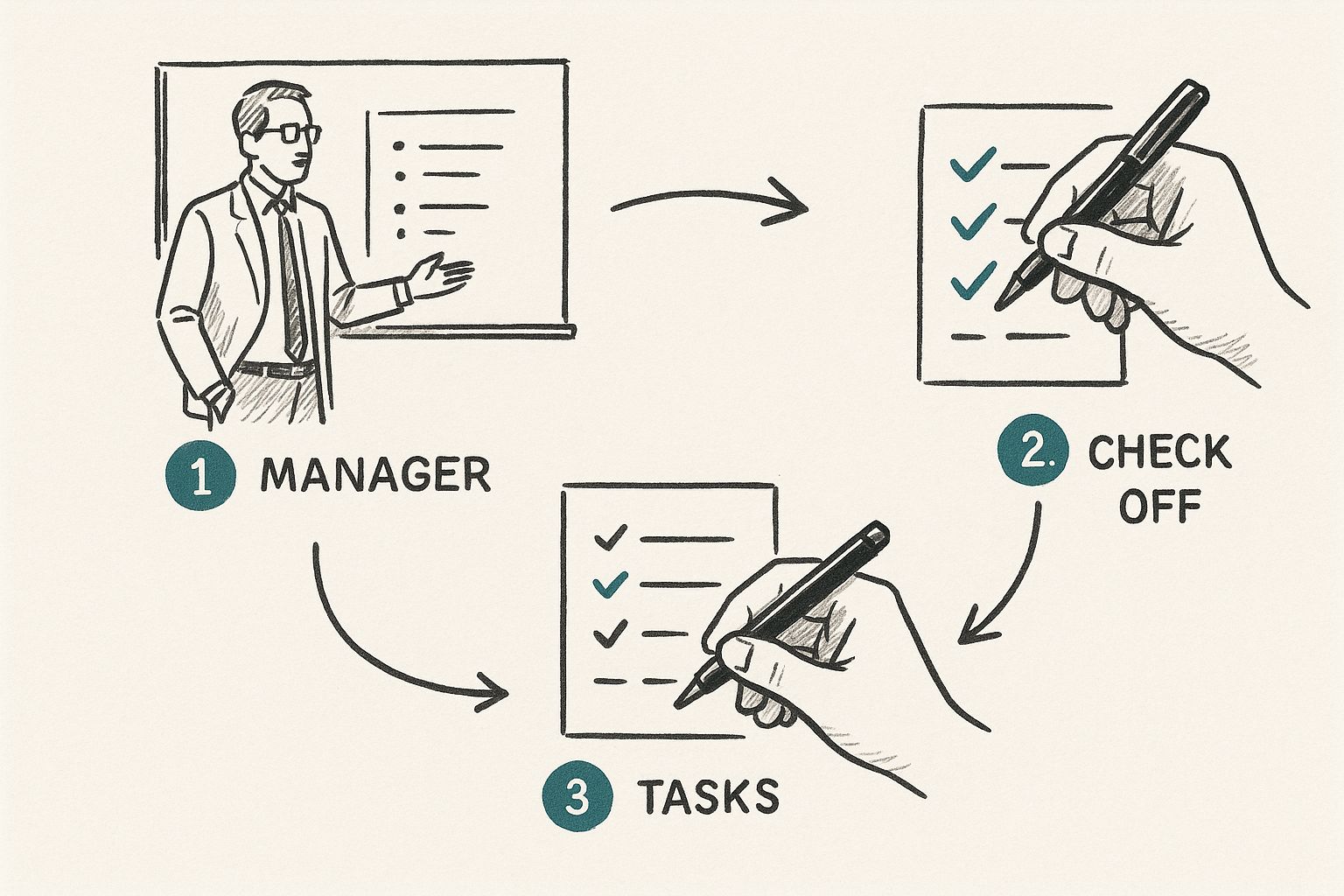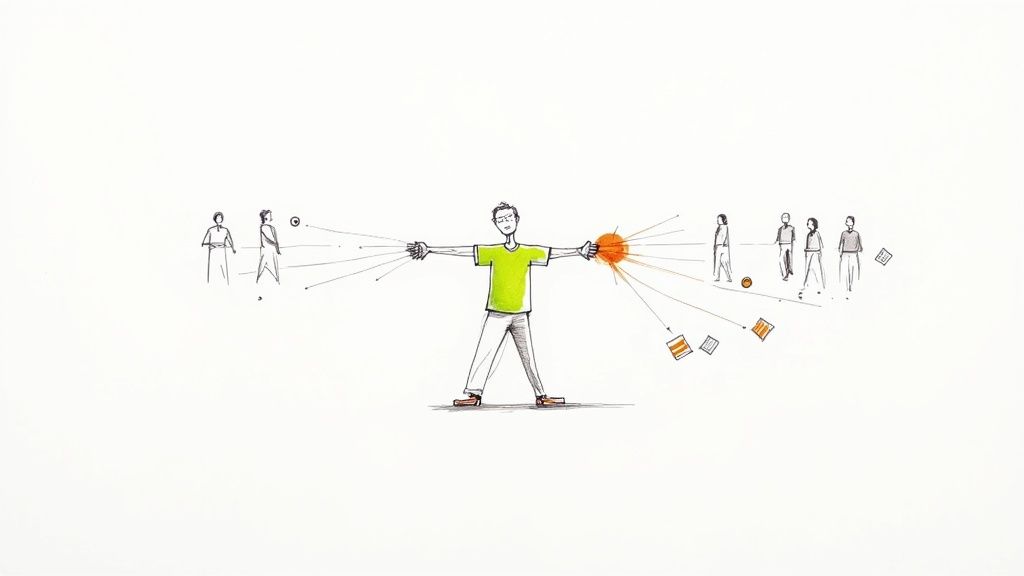Imagine this: it's Friday afternoon, and you're finally closing your laptop, feeling accomplished and relaxed. Your team is crushing their goals, and you've spent the week focused on the big-picture strategy that actually moves the needle. This isn't a fantasy; it's the result of mastering a single skill: effective delegation.
When you delegate effectively, you’re not just offloading work—you're strategically assigning tasks to the right people to help them grow. It's about empowering your team by trusting them with real responsibility, which in turn frees you up to focus on high-impact strategic activities. Making that shift from "doer" to "leader" is absolutely essential if you want to scale.
The True Cost of Doing It All Yourself
It’s a familiar story. Your to-do list is a mile long, your team is stuck waiting for your approval on everything, and the only way out seems to be working later and harder. We’ve all told ourselves, "It's just faster if I do it myself."
That feeling of being the indispensable hero is tempting, but it’s a trap. When you're the only one who can get things done, you become a bottleneck, slowing everyone down.
When you hang onto every single task, you're not just managing your own workload; you're actively stunting your team's growth. This mindset usually comes from a few common fears. We worry about losing control, convinced that no one else can do it exactly right. Or, we feel a pang of guilt, hesitant to add more to a colleague's already full plate.
Recognizing the Bottleneck Effect
These fears, while totally understandable, come with a heavy hidden cost. By making yourself the central hub for every decision and task, you create a system where all progress grinds to a halt the second you’re unavailable.
This doesn't just lead to burnout for you—it crushes your team's potential and motivation. The early warning signs are easy to spot: you're constantly working overtime, your direct reports need your sign-off on minor issues, and real innovation has all but disappeared.
It all comes down to a shift in perspective. True leadership isn't about being the best at doing everything. It's about building a team where everyone is empowered to excel. Moving from a doer to a multiplier is how you unlock genuine, sustainable success.
The impact goes beyond just morale and productivity; it hits the bottom line, hard.
A compelling Gallup study, for instance, found that CEOs who master effective delegation generate 33% more revenue than those who cling to every responsibility. That’s a powerful financial incentive tied directly to empowering your team.
At the end of the day, effective delegation is a strategic investment. It builds trust, develops new skills within your team, and frees you up to focus on the high-level work that actually drives the business forward.
This transition is fundamental for anyone looking to improve team productivity and achieve lasting growth. It's not about giving up control—it's about multiplying your impact through others.
Figuring Out What to Delegate (and What to Keep on Your Plate)
Before you can start handing off tasks, you need a crystal-clear picture of what's actually on your plate. It's easy to fall into the trap of thinking every item on your to-do list needs your personal touch, but that's the fastest way to become a bottleneck. The real skill is learning to separate what's truly vital from what's just time-consuming.
A great place to start is with a quick audit of your weekly responsibilities. Seriously, list everything you do—from high-level strategic planning down to answering those routine emails. Once you have that list, you can start sorting tasks into a few simple categories to see what you should hold onto and what you can pass along.
This process is all about moving from a cluttered list to a strategic action plan. It helps you free up your most valuable resource: your time.

The Four Buckets of Delegation
One of the simplest ways to categorize tasks is by thinking about their impact and whether they require your unique expertise. This step-by-step framework helps you decide what to delegate with confidence.
I like to think of it as four buckets:
- Keep It: These are the high-impact tasks that only you can do. They lean on your specific vision, authority, or strategic insight. Think setting the annual budget or handling a tricky client relationship. These stay with you.
- Delegate It: This bucket is for the time-consuming, repetitive, or lower-impact tasks that don’t need your specific skillset. Things like pulling weekly reports, scheduling meetings, or doing initial data gathering are perfect candidates. Handing these off frees you up for more important work.
- Develop Someone: Some tasks are pure growth opportunities for your team. They might be a bit of a stretch for a team member, but completing them will build their skills and confidence. A perfect example is asking a junior team member to draft the first version of a project proposal.
- Ditch It: Let's be honest—some tasks on your list probably don't need to be done at all. These are the low-impact activities that aren't really moving the needle on your goals. Getting rid of them is the ultimate productivity win.
The goal isn’t to empty your to-do list; it’s to fill it with the right things. Delegating isn't just about offloading work—it's about creating leverage for yourself and development opportunities for your team.
For example, imagine a marketing manager planning a campaign launch. They might realize they spend hours every week pulling social media metrics. This is a classic "Delegate It" task. It's important, but it doesn't require their strategic oversight. By handing this off, they get back precious time to focus on campaign messaging—a "Keep It" task that will directly influence the launch's success.
This small shift doesn't just make them more effective; it also empowers their team with meaningful responsibilities.
Once you’ve figured out what to delegate, breaking those bigger tasks into smaller, more manageable pieces is critical for clarity. For a deeper look at this, check out our guide on the art of task breakdown in Notion. It’s a huge help in making sure everyone knows exactly what needs to be done.
Matching the Right Task to the Right Person

So you've figured out what to delegate. Now comes the most important part: picking the right person for the job. This is where great leaders really shine. It’s not about just looking at job titles and offloading work to whoever has the most free time.
Think of yourself as a casting director. You're trying to find the perfect person to bring a specific role to life. This means looking beyond the org chart and getting to know your team's unique skills, hidden talents, and even their career goals. That quiet junior developer? They might have a secret passion for organizing events, making them the perfect person to lead the next team-building activity. The key is to pay attention.
Look for Strengths and Potential
Take a step back and just observe your team. Who’s the person everyone turns to when a complex problem pops up? Who has a natural gift for calming down an unhappy client? Who gets a weird amount of satisfaction from a perfectly organized spreadsheet? These are all clues to their natural strengths.
When you’re deciding who gets what, I find it helpful to think about three key areas:
- Current Skills: Who can already knock this out of the park with minimal hand-holding? This is your go-to for urgent or critical tasks where there’s no time for a learning curve.
- Growth Potential: Who could learn something valuable by taking this on? Giving someone a task that's just a little outside their comfort zone is one of the best ways to help them grow. For example, let a junior designer take the lead on a small, low-risk part of a big client presentation.
- Motivation and Interest: Who has actually said they want to get better at this? When a task lines up with someone's personal career goals, it stops feeling like an assignment and starts feeling like an opportunity.
This mindset shifts delegation from being a simple productivity hack to a powerful tool for developing your people.
When you align tasks with someone's strengths and goals, you're not just getting work done—you're investing in your team's future. It shows you see their potential and are committed to helping them grow, which is a massive driver of engagement and loyalty.
Starting the Conversation
How you hand off the task is just as important as choosing the right person. Nobody likes having work dumped on their desk. But if you frame it as a genuine opportunity, the whole dynamic changes.
A simple shift in language can make all the difference. Instead of just assigning the task, try opening with something like, "I have a new project coming up, and I immediately thought of you because of your excellent work on [previous project]."
This small change validates their skills and shows you put real thought into the decision. In fact, research shows this kind of mindful delegation can reduce employee turnover by 18%. It creates a far more positive and empowering environment.
Ultimately, getting this match right is a win-win. The work gets done well, your team member gains experience, and you build a more capable, motivated team. To get a better feel for what to look for, check out our guide on essential teamwork skills examples.
How to Set Your Team Up for Success
You've picked the right person for the right task. Great. Now comes the part where many managers stumble.
Simply dropping a task on someone's desk with a casual, "let me know when it's done," is practically a guarantee of frustration and rework. Effective delegation lives or dies in the handoff. You have to set your team member up to win from the very beginning.
Think of it like giving a friend directions to a party. You wouldn't just tell them the city and hope for the best. You'd give them the address, mention the tricky one-way street, and tell them where to park. It's the same principle here. Your job is to provide absolute clarity so they can hit the ground running with confidence.
The Art of the Handoff
A great handoff has nothing to do with micromanaging. It's all about giving someone the context and resources they need to work autonomously. Before you step back, you need to cover the essentials. This initial conversation is your best defense against a thousand follow-up questions and mistakes down the road.
Here’s a simple step-by-step checklist for your delegation briefings:
- Define the "Why": Seriously, start here. Explain how this small task fits into the bigger project or company goal. When people know why their work matters, the quality and engagement go through the roof.
- Clarify the "What": Be painfully specific about the final outcome. What does "done" actually look like? This is often called the definition of done, and it's non-negotiable. For example, instead of "write a blog post," say "write a 1,000-word blog post on topic X, optimized for keyword Y, with two internal links and a call-to-action."
- Provide the "How": Give them everything they need. This could be access to software, contact info for other team members, or links to important documents. Don't make them hunt for it.
- Set Boundaries: Let them know how much authority they have. Can they make decisions on their own, or should they check in with you at certain points? Be clear.
A successful handoff is less about giving orders and more about creating a shared understanding of the goal. When you equip someone with context, resources, and trust, you empower them to solve problems on their own.
Let's use a real-world example. Imagine you're delegating a quarterly client report.
The bad way: "Can you pull the numbers for Q2?"
The better way: "I need you to create the Q2 performance report for our biggest client. The goal is to clearly show them the value we've delivered, so focus on key wins and ROI. All the data you need is in this dashboard, and you have the authority to format the report as you see fit. Let’s aim to have a first draft by Friday."
See the difference? This approach gives them everything they need to succeed on their own. Strong communication is the foundation of this entire process. To make these conversations even more effective, it's worth taking the time to improve team communication skills.
And to make this all repeatable, document your processes. Having well-structured operations manual templates can be a massive help in standardizing how you hand off work.
Mastering Feedback and Follow-Up Without Micromanaging

Handing off a task isn't the finish line; it’s just the starting gun. The real work of delegation happens in the follow-up, but there's a razor-thin line between being a supportive leader and being a frustrating micromanager.
Your goal is to build a safety net, not a cage. You want to create an environment where your team can innovate and even make small mistakes without looking over their shoulder in fear. This is all about building trust. When people know they can bring you challenges without judgment, you unlock a powerful culture of psychological safety. It's the secret sauce for turning a good team into a great one.
Establishing a Rhythm for Check-Ins
The easiest way to avoid the micromanagement trap is to agree on a follow-up rhythm before the work even kicks off. This sets crystal-clear expectations for both of you and kills any need for you to constantly pop in with, "So, how's it going?" It puts your team member in the driver's seat.
This rhythm should feel like a support system, not a surveillance system. Think of it as setting up water stations in a marathon, not standing over someone's shoulder while they tie their shoes.
Here are a few simple but effective check-in structures you can use:
- For Complex Projects: Schedule quick, 15-minute weekly syncs. Use this time to discuss progress, roadblocks, and what’s next on the list.
- For Straightforward Tasks: Agree on a simple end-of-day or end-of-week summary over Slack or email. No meeting required.
- For Urgent Deadlines: A quick daily stand-up can keep everyone aligned and helps you tackle any surprise issues immediately.
The right approach depends entirely on the task's complexity and the person's experience level. A senior team member might only need a single check-in before the deadline, while a junior colleague could benefit from more frequent touchpoints.
Your role shifts from director to coach. Instead of dictating every move, you're there to offer guidance, remove obstacles, and ensure your team member has everything they need to succeed on their own terms.
Giving Feedback That Fuels Growth
Sooner or later, a delegated task won't go exactly as planned. This isn't a failure; it's a golden opportunity for growth. How you handle this moment defines your leadership and shapes whether your team will be willing to take risks in the future.
When an outcome isn't quite right, fight the urge to jump in and fix it yourself. That just teaches them that you're the hero who saves the day. Instead, use it as a coaching moment to build their skills for next time. Remember: effective feedback is about the work, not the person.
Here’s a simple, step-by-step framework for giving constructive feedback that actually helps:
- Start with the Positive: Always acknowledge the effort and point out what went well. This builds trust and makes the other person far more receptive to what comes next.
- Be Specific About the Gap: Clearly and calmly explain the difference between the outcome and the expectation. Vague statements like "this isn't quite right" are useless. Instead, try something like, "The report captured all the key data points perfectly, but it was missing the executive summary we talked about."
- Collaborate on a Solution: Turn it into a problem-solving session. Ask questions like, "What do you think we could do differently next time?" or "What challenges did you run into that we didn't expect?" This empowers them to find the solution.
By mastering this follow-up loop, you're doing more than just getting tasks off your plate. You're building a resilient, self-sufficient team that gets better with every project. This is how you delegate in a way that creates lasting growth for everyone.
Common Questions About Delegating Tasks
Even with the best-laid plans, you're going to hit a few snags when you start delegating more. It’s totally normal. Pushing past these final hurdles is what builds real confidence in your process. Let's tackle the questions that come up most often for managers.
What If It Isn’t Done to My Standards?
This is the big one, isn't it? It’s probably the single biggest fear that holds leaders back from letting go.
The trick is to shift your focus from demanding your exact method to celebrating the final outcome. If the goal was hit, the task was a success—even if they took a different path to get there.
From the very beginning, give them a crystal-clear definition of done. If the work they hand back meets those criteria, it’s a win. If there are a few small gaps, fight the urge to jump in and redo it yourself. Instead, use it as a coaching moment to help them sharpen their skills for next time.
How Do I Delegate to Someone Already Busy?
This calls for a real conversation, not just another task dropped on their to-do list. Good delegation is often about reshuffling priorities, not just piling more work onto a full plate.
Start by sitting down and looking at their current workload together.
Can you find anything to clear off their plate? Maybe there are lower-priority tasks they could push back, automate, or even delegate to someone else. Frame this new task as a growth opportunity that lines up with their career goals. That way, it feels less like a burden and more like a smart investment of their time.
Delegation isn't about adding to someone's burden. It's about strategically reallocating responsibilities to elevate the entire team's capabilities and focus.
Isn’t It Just Faster to Do It Myself?
In the short term? Almost always, yes. But that thinking is a trap. It keeps you buried in work and stops your team from growing.
The time you put in upfront to teach someone pays off in a huge way down the road.
Think of it this way: spending 30 minutes today teaching a task could save you 10 minutes every single day from now on. Delegation is a long-term investment in your team’s abilities and, more importantly, in your own time and sanity. For a deeper dive into this, check out this comprehensive guide on how to delegate tasks effectively.
Ready to put all this into practice? With the Nora Template for Notion, you can assign tasks, define clear outcomes, and track everything without having to micromanage. Transform your project management and empower your team by visiting https://www.noratemplate.com to get started.

.svg)




